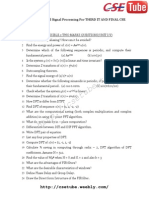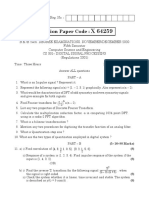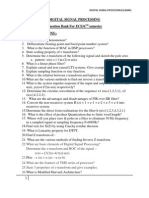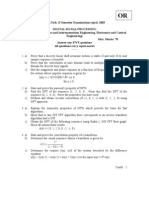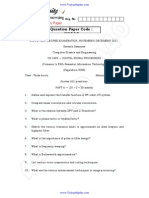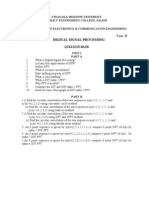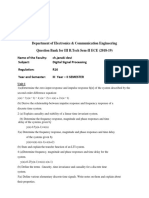0 ratings0% found this document useful (0 votes)
1K viewsCusat DSP Question Paper
Cusat DSP Question Paper
Uploaded by
Sabith PockerExplain the terms (i) convolution (ii) up sampling (iii) down sampling. Determine the impulse response and step response of the system OR State and prove scaling property of Z-transform. Explain the term circular convolution and how it is different from linear convolution.
Copyright:
Attribution Non-Commercial (BY-NC)
Available Formats
Download as PDF, TXT or read online from Scribd
Cusat DSP Question Paper
Cusat DSP Question Paper
Uploaded by
Sabith Pocker0 ratings0% found this document useful (0 votes)
1K views14 pagesExplain the terms (i) convolution (ii) up sampling (iii) down sampling. Determine the impulse response and step response of the system OR State and prove scaling property of Z-transform. Explain the term circular convolution and how it is different from linear convolution.
Original Title
Cusat Dsp Question Paper
Copyright
© Attribution Non-Commercial (BY-NC)
Available Formats
PDF, TXT or read online from Scribd
Share this document
Did you find this document useful?
Is this content inappropriate?
Explain the terms (i) convolution (ii) up sampling (iii) down sampling. Determine the impulse response and step response of the system OR State and prove scaling property of Z-transform. Explain the term circular convolution and how it is different from linear convolution.
Copyright:
Attribution Non-Commercial (BY-NC)
Available Formats
Download as PDF, TXT or read online from Scribd
Download as pdf or txt
0 ratings0% found this document useful (0 votes)
1K views14 pagesCusat DSP Question Paper
Cusat DSP Question Paper
Uploaded by
Sabith PockerExplain the terms (i) convolution (ii) up sampling (iii) down sampling. Determine the impulse response and step response of the system OR State and prove scaling property of Z-transform. Explain the term circular convolution and how it is different from linear convolution.
Copyright:
Attribution Non-Commercial (BY-NC)
Available Formats
Download as PDF, TXT or read online from Scribd
Download as pdf or txt
You are on page 1of 14
BTS(C) OSl(A)
B. Tech. Degree VI Semester Examination, July 2002
I
Time: 3 Hours
II
III
IV
v
VI
VII
VIII
IX
x
CS/EC/EI 601 DIGITAL SIGNAL PROCESSING (1999 Admissions)
Max. Marks: 100
(All questions carry equal marks)
a) b)
Explain the terms (i) convolution (ii) up sampling (iii) down sampling. Determine the impulse response and step response of the system
y(n) = ei y(n -1) - x(n) given that y(n) '" 0 for n < 0
OR
State and prove scaling property of Z-transform. Determine the inverse transforms of
(i) X(z) = } -2 ROC Izl>1
r-i.se +0.5z
a) b)
(ii)
X(z) '" 2 1 ROC Izi > 1
z -1.2z+0.2
a) b)
Explain the term circular convolution and how it is different from linear convolution. A sequence x( n) ::: {-I. O,l,O} is to be convolved with another sequence
y( n) '" {I, -I, 0, I} to produce w(n). Determine wen) using circular convolution.
OR
Show that to any DIT FFf algorithm there corresponds to an inverse transform algorithm that is decimation in frequency.
Compare the multiplications and additions involved in radix 2 FFf algorithm and direct computation of DFf.
a)
b)
a) b)
Explain frequency sampling method of FIR filter design. .
Using frequency sampling method, design a filter whose magnitude characteristic is given by
H(O) "" H(l) = H(15)::; 1 and
H(k)==O for k '" 2,3, 14
Realize the filter.
a) b)
OR
Compare the characteristics of different windows used in filter design.
Design a linear phase FIR digital filter for a -·3dB cut-off frequency of 30 n rad/sec. and attenuation of 50 dB at 45 1C rad/sec with a sampling rate of 100 per sec. Realize the filter.
a) b)
Explain bilinear transformation as applied to the design of digital filters. Realize the following IIR filter using bilinear transformation.
H(s) = 2S2 +3s+3 sl-lOs+S
Draw the block diagram of the resulting transfer function.
OR Compare Butterworth and Chebyshev filters.
Design an IIR filter using bilinear transformation -5 dB at 600 Hz Monotonic stop and pass band response at least -16 dB at 1 KHz. Sampling rate 20001sec.
a) b)
a) b)
Describe briefly anyone application of DSP.
Explain how fixed point and floating point representation are used to represent numbers in a digital system,
OR
a) b)
Explain what is meant by truncation and rounding. Explain the architecture of a typical DSP processor briefly.
* ••
BTS(C)-VI-03- 516 (A)
B. Tech Degree VI Semester Examination
~ May 2003
CSIECIEIlEE 601 DIGITAL SIGNAL PROCESSING
( 1999 Admissions onwards) .
Time: 3 Hours Maximum Marks: 100
I. (a) Check whether the following systems are linear, time-invariant causal and stable.
(i) yen) = x(2n)
(ii) yen) = x(n) + n x(n+ 1) (12)
(b) Determine the response of the relaxed system characterized by an impulse response
j. hen) = (t r u(n) to an input sequence x(n) = zn u(n). (8)
'>.!
OR
II. (a) Determine the impulse response hen) of a causal and stable L TI system whose input x(n)
and output yen) are related by the difference equation y(n)- t yen-I) - t y(n-2) = x(n). (8)
(b) Find out the z-transform and ROC of the finite duration sequence x(n) = {2,4,5,7.0,1}. (4)
(c) Determine all possible signals associated with X(z) = 1 _~ I -2 (8)
1-2'z +4'z
m. (a) State and prove time shifting property of OFT. (8)
(b) Compute the OFT of the sequence {1.1,-2,-2}. (8)
(c) Establish the relationship between OFT and Z-transform. (4)
OR
IV. (a) Distinguish between linear and circular convolution of 2 sequences. (6)
(b) What are the differences and similarities between Dl'I' and DIF algorithms? (8)
J (c) Explain the following terms:
-' (i) in-place computation.
, (ii) butterfly structure. ~
V. (a) Obtain a cascade realization involving minimum number of delays for a system having
transfer function H(z) '" (1 + Z-I )et - tz-I +tz-2) (6)
(b) Explain the different techniques for FIR filter design. (14)
OR
VI. (a) State the principle of windowing. What are the· desirable characteristics of a window. (10)
(b) Design an FIR filter satisfying the following specifications using Fourier Series method
H(ciw) = 0 o SlwlS 1t'13
=1 otherwise. (10)
VII. (a) Explain in detail, any two methods for digitizing the transfer function of an analog filter. (10)
(b) Realize the following transfer function using cascade and parallel structures.
H(z) = 0.44z2 +0.362z + 0.02 (10)
.. Z3 +O.4z2 +0.18z -0.2
-
OR
VIII. (a) What is bilinear transformation ? State its advantages and disadvantages. (8)
(b) Using bilinear transform, design a high pass filter, monotonic in pass band with a
cut-off frequency of 1000Hz and down lOdB gain at 350 Hz. The sampling frequency
is 5000Hz. (12)
IX. (a) Find the steady state noise power due to product roundoff in the realization of the
transfer function H(z) = 1 -I' (8)
1-az
(b) Explain the different types of arithmetic employed in digital systems, bringing out their
merits and demerits. (12)
OR
(a) Explain briefly the major application areas of digital signal processing. (12)
(b) What is meant by limit cycle oscillations? Why this problem does not exist in FIR
digital filters? (8)
."'''' BTS(C). VI ·05 .O~ (C)
B. Tech. Degree VI Semester Examination June 2005
CSIEI/EE 601 DIGITAL SIGNAL PROCESSING ( 2002 Admissions)
Time: 3 Hours
Maxim.um. Marks: 100
L (a) Check whether the following systems are static, causal, linear. time invariant and stable:
(i) y(n) = ne%(II)
(n)
11+1
y(n)= L x(k)
k=--
(15)
n
(b) The unit step response of a system is given by Tn u(n), find the impulse response of the system.
OR
(a) Show that the LTI systems are stable if and only if ~
I Ih(k)l<ao
k=--
(5)
(5)
(b) Find the inverse Z - transform of X(.) given by
Z2 . 1
X(z) = ( ). ;Roc:lzl>-.
. z-t (Z-i) 2
(c) Find the Z» transform of the sequence x(n) defined below:
(8)
x(n)= 3". n « 0
(tf, n = 0.2.4 .
(tf, n = 1,3,5, .
(7)
(TurnOver)
m.
Iv.
\
.•
2
3
Vlll (a) Obtain the direct form I. direct form II, cascade and parallel
form realization of the following systems:
1
y(n) = y(n-I)-2" y(n-2)+x(n) -x(n:-l)+x(n-2) (16)
(b) Compare llR and FIR filters. (4)
IX. (a) Draw and explain the block diagram of a typical OSP
processor. (12)
(b) Discuss the effect of round -off noise in digital filter
implementation. (8)
OR
X (a) Briefly explain any three applications of Digital Signal
processing. (12)
(b) What is meant by limit cycle oscillations? lllustrate with
examples. (8)
••• (a) (b)
Explain in detail the properties ofDFr. (10)
Compute the linear convolution of the two sequences
.t(II) = {l.2.2.I}and h(.,) = {f,2,3}USingDIT-FFf. (10)
OR
Describe the orr - FFt algorithm. (10)
Compute the 8 point OFT X (k) of the real ~uence
x(n) = {l,l,l,l,-l,-l,-I,-I} by using DIF -FFf algorithm. (10)
(a) (b)
Explain the frequency sampling method of FIR filter design. (10) Design a low pass FIR filter for the following specifications :
H(jw)=l for n~5rad/sec =0 for Q>5rad/sec.
Sampling frequency 20 rad/sec. Use Fourier series method
with N == 9 and Hamming window for the design. (10)
OR
VI (a) Explain the principle of FIR filter design using windows. (10)
(b) Using rectangular window technique design a low pass filter with pass band gain of unity, cut-offfrequency of 1500 Hz and working at a sampling frequency of 5 KHz.
The length of the impulse response should be 7. (10)
(a) (b)
vn. (a) Explain the bilinear transformation method for the design
of digital filters. (10)
(b) A third order butterworth low pass filter with 3dB frequency of I KHz is to be realized using digital systems. Assume sampling frequency to be 5 KHz. Realize the filter using
impulse invariant technique. (lO)
OR
COntd ...... 3
BTS(C) -VI - (S) - 05 - on(C}
B.Tech. Degree VI Semester (Supplementary) Examination, November 2005 CSIEIlEE 601 DIGITAL SIGNAL PROCESSING
(2002 Admissions)
Time: 3 Hours Maximum Marks: 100
a) Explain the different basic properties of discrete system with example. (8)
b) Check the y(n}91x(n) system are time invariant, Linear as static (6)
c) Explain the classification of discrete time signals. (6)
OR
II a) Evaluate the convolution y(n)=x(n)*h(n) of the sequence
x(n) = {1,I,O, 1, I} and
t
hen) == {1,-2,-3,4} (7)
t
b) Explain the important properties of the ROC of the z-transform. (5)
c) Determine the causal signals x(n) having z-transform xCz) = -1 I -I 2 (8)
(1+z )(1-z )
III a) Find the convolution of the two signals x(n) = u(n) and h(n)=a'U(n) ROC
lal < l,n::?: o. (10)
b) Explain any five properties ofDF1'. (10)
OR
IV a) Find the 4 point DFT of the seg x(n) = ~ . (10)
4
b) Explain the Radix-2 DlT FFT algorithm, (10)
V a) Determine direct form I and II and cascade form for the realization for the transfer
f 1\ of an FIR system is given by H(z) = (l_.!.Z-1 +lz-2)(1-'!'z-I_'!'z-Z) (9)
4 8 8 2
b) Discuss the cascade realisation of FIR system. (4)
c) Design FIR filter using FS method and discuss Cribb's oscillation and how to reduce
cribb's oscillations. (7)
OR
r «> -311" s Iml s 3;r
VI a) The desired response of a LPF is Hd(e") ~ 1 \ 4
. 0 _:: < Iml :s; 11"
• 4
Determine H( e-jlw) for M=7 using a Hamming window. (lO)
. [e-'" O~ws~
b) A LPF has the desired response as Hd(ei"') = 0 ~~ms1l"
Determine the filter co-efficients h(n) for M=7 using type I frequency sampling
techniques. (10) (Turn Over)
VII
VIII
IX
x
2
a) b)
Compare Butterworth and Chebychev filter.
Convert the following analog filter into digital filter using impulse inv~iant method.
R._ -~-- ---~.----
0- ...fV'NV\ I p
'\' Q
S c \) YP Tc p)p
~ (c) Obtain direct form I and II cascade and parallel form realization for the following system.
a)
yen) = -O.ly(n -1) + O.2y(n -2) +3x(n) +3.6x(n -1) + O.6x(n -2)
OR
What is the mapping procedure between S plane and Z plane in the method of mapping of differential? What are its characteristics?
Design a Chebychev filter for the following specification.
0.8:f; IH(el"')1 S; 1 . O:S; IV S; 0.2tr
IH(ej.,»):s; 0.2 o.se s IV:S; 7Z'
using i) bilinear and (ii) impulse invariant method.
b)
a)
Write short notes on:
i) Limit cycle oscillations
ii) Quantization effecting the computation ofDFT.
Explain the application of DSP in image processing.
OR
Draw and explain the architecture ofa typical DSP processor.
What are the effects offinite word length in digital filter? Explain the Rounding and Truncation error.
b)
a) b)
•••
(4) (6)
(10)
(6)
(14)
(10) (10)
(10) ( 10)
"
BTS(C) -VI - (S) - 05 - on(C)
B.Tech. Degree VI Semester (Supplementary) Examination, November 2005 CSIEIlEE 601 DIGITAL SIGNAL PROCESSING
(2002 Admissions)
Time: 3 Hours Maximum Marks: 100
I a) Explain the different basic properties of discrete system with example. (8)
.. b) Check the y(n)=nx(n) system are time invjIiant, Linear as static (6)
c) Explain the classification of discrete time signals. (6)
OR
II a) Evaluate the convolution y(n)=x(n)"'h(n) of the sequence
x(n) = {I,I,O,I,I} and
t
hen) = {1,-2,-3,4} (7)
t
b) Explain the important properties of the ROC of the z-transform, (5)
c) Determine the causal signals x(n) having z-transform x(z) = _I I _I 2 (8)
(1 + z )(1- z )
III a) Find the convolution of the two signals x(n) = 'ten) and h(n)=a~(n) ROC
lal < 1,n ~ O. (10)
b) Explain any five properties ofDFP. (10)
OR
IV a) Find the 4 point DFT of the seg x(n) =~. (10)
. 4
b) Explain the Radix-2 O1r FFT algorithm. (10)
V a) Determine direct form I and II and cascade form for the realization for the transfer
f 1\ ofan FIR system is given by H(z) = (l_.!..Z-1 +~z-2)(I-.!.z-1 _'!'Z-2) (9)
4 8 8 2
b) Discuss the cascade realisation of FIR system. (4)
c) Design FIR filter using FS method and discuss Cribb's oscillation and how to reduce
cribb's oscillations. (7)
OR
. . r e-jJ", -3.1r simi s 3Jr
VI a) Th. desired response of. LPF is Hd( e~) • t \ 4
o __::_ < I~ s .1r
4
Determine H( e-J3",) for M=7 using a Hamming window. (10)
b) A LPF has the desired response as Hd( e'") = [ :- ". O~m~~
~ SmSJr
Determine the filter co-efficients h(n) for M=7 using type I frequency sampling
techniques. (10) (Tun. Over)
VII
VIII
IX
x
2
a) b)
Compare Butterworth and Chebyehev filter.
Convert the following analog filter into digital filter using impulse inv~iant method.
S t\)
- .. - - 1(- .. - ---~---~~.
~-/\NVV'I YP ~T
GL\;) .j c.
~---~-:___---o
(c) Obtain direct form I and II cascade and parallel form realization for the following system.
a)
yen) =- -O.ly(n -1) + O.2y(n -2) + 3x(n) + 3.6x(n -1) + 0.6x(n -2)
OR
What is the mapping procedure between S plane and Z plane in the method of mapping of differential? What are its characteristics?
Design a Chebycbev filter for ~e following specification.
0.8:S IH(~")I:s 1. 0 s eo s O.2.1r
IH(ej"t~ 0.2 0.6.1r s m:S.1r
b)
using i) bilinear and (ii) impulse invariant method.
a)
Write shDl't~n:
i) Limit cycle oscillations
ii) Quantization effecting the computat"l6n of OFT.
Explain the application ofDSP in image processing,
OR
Draw and explain the architecture of a typical DSP processor.
What are the effects of finite word length in digital filter? Explain the Rounding and Truncation error.
b)
a) b)
•••
(4) (6)
(10)
(6)
(14)
(10) (10)
(10) (10)
STS(C) - VI - 06 - 017(C)
B.Tech. Degree VI Semester Examination, June 2006
Time: 3 Hours
CSIEIIEE 601 DItGIT AL SIGNAL PROCESSING (2002Admissions)
Maximlllll Marks: 100
a) Test the following systems for the properties of linearity, causal ity, time invariance and stability.
(i) yen) == men) (ii) y(n)=x(n)-x(n-I) , (4+4=8)
b)
11
a)
b) c)
III
IV
v
VI
Obtain and sketch the impulse response of a system described by yen) == O.4x(n)+x(n -1) +O.6x(n -2) +x(n-3)+O.4x<n -4)
OR
Find the one sided Z transform of tile following sequence.
x(n) =na"!
Find the inverse Z transform cf X(z) = ~ . 1
1-1.5z- + O.5z-
Determine the impulse response for the cascade of two LTI systems with impulse responses.
~(n)=(~J u(n) ard ~(n)==(~T u(n)_
a) b) c)
State and prove the time shifting property ofDFT. Express the relation between Z transform and OFT.
Using OFT perform circular convolution of the two sequences .
x(n) = Cos ( If;) n :::0,1,2,3 and hen) =2" n == 0,1,2,3.
OR
Detennine the response of an L TI system by radix 2 OITFFT whose input is
x(n) == {l,t,l} and impulse response ish(n) = {-I,-I}
a)
Draw the direct form structure of the FIR system described by t te transfer function.
( 1 -I 3 -1 I -3 1 ... 1 -5
H z) = 1 +-z +-.~ +-z +-z +-z
2 4 4· 2 8
Describe the fonowing window functions with their responses.
(i) Hanning Window (ii) Hammin! window
Describe the fourier series method of filter design.
OR
Design a HPF using hamming window with a cut off frequency of 1.2 rad/sec
and N-=9
b)
c)
(12)
(5) (5)
(10)
(8) (2)
(10)
(20)
(5) (8) (8) (7)
(20)
(Turn Over)
2
VII a) Obtain the direct fonn 1 and direct from II realizations of discrete time system
represented by the transfer function .
H(z}= 8z3-4zz+11z-2 (10)
(z- ~XZ2 -z+ ~)
b) Describe 5 properties each of Butterworth filters and Chebyshev filters. (10)
OR
VIII Design a Butterworth IIR digital filter using bilinear transfonnation for the
specifications.
I
J2 s jH(w)j s 1.0 OSwSO.2n
IH(w) S 0.08 O.41f S w Sn (20)
IX a) Draw and explain the block diagram ohoy typical DSP processor. (l0)
b) What is meant by finite word length effects in digital filters? (5)
c) Compare fixed point and floating point number arithmetic. (5)
OR
X a) Explain limit cycle oscillations with an example. (5)
b) Explain truncation and rounding. (5)
• •• BTS (C).- VI- 08 - 006 - C
B. Tech Degree VI Semester Examination, April 2008
Time: 3 Hours
I.
(a)
(b)
II.
(a) (b)
(c)
111.
(a) (b)
IV.
(a)
(b)
V.
VI.
CSIEIlEE 601 DIGITAL SIGNAL PROCESSING (2002 Scheme)
Maximum Marks: 100
Check the linearity, time invariance, causality and stability of the following systems:
(i) yen) = nx(n)
(ii) y(n) = x(n2)
(iii)
"
yen) = L x(k)
k= __ .
Determine the steady state response for the system with impulse function hen) = (; J u(n) for an input ~(n) = (cos ttn )u(n).
OR Explain the properties of z - transform.
Define system function and find the system function and impulse response of the system described by the difference-equation
yen) = x(n) + 3x(n -1)-"t2x(n - 2) + x(n - 3).
Find the stability of the system whose impulse response hen) = 2"u(n).
Explain the properties of discrete fourier transform, Find the IDFT of the sequence
X(k) == {S,O,I- j,O,I,O, 1 + j,O}.
OR
Find the output, y( n) of a filter whose impulse response is h( n) = {I, 1,1} and
input signal x(n) = {3, 2,1,0, I, 2,3, -1, 2, I} using overlap save method.
Find the DFT of the sequence x(n) using DIT FFT algorithm.
x(n) = {2,2,2,2,1,1,1,1}.
(a) (b)
Explain the relevance of window function and explain each window.
Design a high pass filter using harruning window with a cut off frequency of 1.2 radians/sec.
OR
(a) (b)
Explain frequency sampling method of FIR filter design.
Obtain the direct and cascade form realization of the system function
H(z) == 1 +~Z-l +2z-2 + 2z-J
2
(Turn Over)
(4) (4)
(4)
(8)
(10)
(6) (4)
(10)
(10)
(10)
(10)
(10)
(10) (10)
(10)
VII.
VIII. (a)
IX.
X.
2
Realize the system in cascade and parallel form
H(z) = 1+ 12 Z-l
(1-z-1 +Y.;z-2)(1-z-1 + XZ-2)'
(b) Convert the analog filter with system function H. {S) in to digital filter using bilinear transformation
(a)
(b)
H(S)= S+O.1
(> (S+0.1)2+16
OR
Explain warping effect on magnitude and phase response in an IlR filter. How this can be eliminated?
Design a chebyshev digital filter using impulse invariant transformation with following specification :
0.9 S IH(w)1 s 1.0; 0 S w S 0.257r
IH(w)1 S; 0.24; O.S7r S; w S; n
(a) (b)
Write short notes on :
(i) Fixed point and floating point arithmetic
(ii) Truncation and rounding errors in digital filters
(iii) Product quantization error
(iv) Limit cycle oscillation
OR
Draw and explain the architecture of a typical DSP processor. Explain any one application of digital signal processing.
***
(10)
(10)
(8)
(12)
(5) (5) (5) (5)
(I 0) (10)
BTS(C) - VI - 09- 006 - C
....
Time: 3 Hours
I.
(a)
II.
III.
IV.
B. Tech Degree VI Semester Examination, April 2009
CSIEIIEE 601 DIGITAL SIGNAL PROCESSING (2002 Scheme)
Maximum Marks: 100
Determine the zero-input response of the linear time invariant discrete time system described by the difference equation
Y(k + 2) -0.6 y(k+ 1)-0.16 y(k) = 5x(k +2)~ with
25 .
y(-l)=O~ y(-2)=4' y(k) denotetheo/pand x(k) denote the input. (to)
(b) Use z - transform to perform the convolution of the following two sequences.
h(n)=(~J 0~n~2
(a)
= 0 else
, x ( n) = 8 ( n ) + 8 ( n -1) + 48 ( n - 2) .
OR
Consider a system whose output y( It) is related to the input x( n) by
(10)
a
y(n) = I x( k )x(n + k). Determine whether the system is
k=-a
(i) Linear (ii) Shift invariant
(iii) Stable (IV) Causal (10)
(b) Prove (i) Commutative property
(ii) Distributive property of convolution. (10) (a) (b)
Discuss the circular shift property ofDFT. (5)
G (k) and H (k) are 6 point DFT of the sequences g (n) and h( n) respectively.
The DFT of G (k) is given as
G(k)= {I + j, -2.1 + j3.2,-1.2 - j2.4,0, 0.9 + j3.1, -0.3 + jl.l}
. The sequences g (n ) and h (n ) are related by the circular time shift as h (n) = g [< n - n > N ]. Det~rmine H (k) without computing DFT.
OR
Discuss the Linearity and Conjugate Symmetry property ofDFT.
First five points of the eight point DFT of a real valued sequence is given by
X[0]=0,XP1=2+ j2, X[2]=-j4,X[3]=2- j2,X[4]=0.
(15)
(a) (b)
(5)
Determine the remaining points. Hence find the original sequence x( n) using DIFFFT
algorithm. Also draw the butterfly diagram. (15)
(Turn Over)
v.
VI.
2
(a)
Obtain the direct form and cascade form realization of the transfer function for an
() (1 1 -1 3 -2) ( 1 -1 1 -2 )
FIRsystem given by H'i z+» --z +-z I--z --z .
. . 4 8 8 2
What is Gibb's Phenomenon? What is the principle of designing FIR filter using windows? Write the equation for any four window function.
OR
Discuss the Fourier series method of designing FIR Filters. Design an FIR HPF with the frequency response
Hd (e/w) = 1 for -; :5 w:5 7l"
= 0 for Iwl:5 1l'14
Using Hanning Window. Take N = 11 ,
(10)
(10) (5)
(IS)
VII. (a) Obtain the direct form I and II for the second order lIR Filter given by
y(n) = 2bCoswoy(n-I)-b2y(n -2)+x(n)-bCoswox(n -I). (10)
2
(b) For the analog Transfer function H (s) = ( ) ( ) ,determine H ( z) using
s+1 s+2
impulse invariance method. Assume T = 1 second. (10)
OR
VIII. (a) Explain bilinear transformation. (5)
(b) Design a digital butter worth IIR filter satisfying the specification.
0.707 :5IH (e1w)! :5 1 for O::::;W:5~
IH( eiw)1 :5 0.2 for 37l"
-:5w:5Jl"
2·.
with T = 1 sec. Using bilinear transformation and realize the filter in direct form Il, (15) IX.
(a) (b)
x.
(a) (b)
(b)
(a) (b)
Explain fixed point arithmetic and floating point arithmetic.
Discuss the coefficient quntization effects in direct form realization ofIIR filter.
OR List the features ofDSP processor.
Explain the architecture of a ~pical DSP processor with a neat diagram.
***
" , "
(10) (10)
(5) (15)
You might also like
- DSP QuestionsDocument8 pagesDSP Questionsjjshree79No ratings yet
- DSP PDFDocument0 pagesDSP PDFvelkarthi92No ratings yet
- CS331 Digital Signal Processing Apr May 2004Document3 pagesCS331 Digital Signal Processing Apr May 2004Chandru SekarNo ratings yet
- Question Paper Code:: Reg. No.Document3 pagesQuestion Paper Code:: Reg. No.DhariniJeevanandamNo ratings yet
- Question Paper Code:: (10×2 20 Marks)Document3 pagesQuestion Paper Code:: (10×2 20 Marks)ManimegalaiNo ratings yet
- CS331 Digital Signal Processing Nov Dec 2003Document3 pagesCS331 Digital Signal Processing Nov Dec 2003Chandru SekarNo ratings yet
- Question Paper Code:: Reg. No.Document2 pagesQuestion Paper Code:: Reg. No.Naveen KumarNo ratings yet
- B.E Degree Examinations: April/May 2016Document3 pagesB.E Degree Examinations: April/May 2016PRAVEEN O.KNo ratings yet
- Signals & Systems EC403Document3 pagesSignals & Systems EC403Shashank M ChanmalNo ratings yet
- DSP February 2023Document2 pagesDSP February 2023dedoga9086No ratings yet
- Assignment For B.Tech ECE: X N X KDocument3 pagesAssignment For B.Tech ECE: X N X KTanmay GoelNo ratings yet
- Ec DSP Sup 2014Document2 pagesEc DSP Sup 2014Akho John RichaNo ratings yet
- ECE III II DSP ContentDocument40 pagesECE III II DSP ContentAvigyan BasuNo ratings yet
- DSPDocument12 pagesDSPAshish Chandrakant ChavanNo ratings yet
- Question Paper Code:: (10 2 20 Marks)Document3 pagesQuestion Paper Code:: (10 2 20 Marks)Santhosh UskNo ratings yet
- DSP4Document3 pagesDSP420001015503 MANAWWAR HUSSAINNo ratings yet
- Ec301 Digital Signal Processing, January 2022Document2 pagesEc301 Digital Signal Processing, January 2022sandraNo ratings yet
- Assignment QuestionsDocument3 pagesAssignment QuestionssudhamaniNo ratings yet
- DSP QB FULL - DraftDocument5 pagesDSP QB FULL - Draftssabeshadithya05No ratings yet
- DTSPDocument4 pagesDTSPmonisa kannanNo ratings yet
- PART A (10 X 2 20 Marks)Document5 pagesPART A (10 X 2 20 Marks)dhakaruNo ratings yet
- r05320201 Digital Signal ProcessingDocument8 pagesr05320201 Digital Signal ProcessingBharath LudiNo ratings yet
- Digital Signal Processing QUESTION BANKDocument5 pagesDigital Signal Processing QUESTION BANKSaran SekaranNo ratings yet
- JNTU Old Question Papers 2007Document8 pagesJNTU Old Question Papers 2007Srinivasa Rao G100% (1)
- Or-421051 - Digital Signal ProcessingDocument2 pagesOr-421051 - Digital Signal ProcessingSrinivasa Rao GNo ratings yet
- Rr410201 Digital Signal ProcessingDocument8 pagesRr410201 Digital Signal ProcessingRohan GaonkarNo ratings yet
- Ec301 Digital Signal Processing, December 2020Document3 pagesEc301 Digital Signal Processing, December 2020sandraNo ratings yet
- 07a51101 Digital Signal ProcessingDocument8 pages07a51101 Digital Signal ProcessingSRINIVASA RAO GANTANo ratings yet
- C F1048 Pages:2: Answer Any Two Full Questions, Each Carries 15 MarksDocument2 pagesC F1048 Pages:2: Answer Any Two Full Questions, Each Carries 15 MarksGlan DevadhasNo ratings yet
- III Year - Electronics and Communication Engineering Ec 6502 - Principles of Digital Signal ProcessingDocument8 pagesIII Year - Electronics and Communication Engineering Ec 6502 - Principles of Digital Signal ProcessingYokesvaran KNo ratings yet
- Question Paper Code:: Reg. No.Document2 pagesQuestion Paper Code:: Reg. No.Nithiya MaharajanNo ratings yet
- II B. Tech I Semester, Regular Examinations, Nov - 2012 Signals and SystemsDocument8 pagesII B. Tech I Semester, Regular Examinations, Nov - 2012 Signals and Systemssateesh83No ratings yet
- r05320201 Digital Signal ProcessingDocument8 pagesr05320201 Digital Signal ProcessingSRINIVASA RAO GANTANo ratings yet
- Cs2403 DSP Nov 2011 QPDocument3 pagesCs2403 DSP Nov 2011 QPvijayshankar743No ratings yet
- Semester: IV Year: II: Digital Signal ProcessingDocument5 pagesSemester: IV Year: II: Digital Signal ProcessingShipra ChoudharyNo ratings yet
- Signals & Systems SyllabusDocument4 pagesSignals & Systems SyllabusShareef KhanNo ratings yet
- DSP - QP-2nd Edition PDFDocument12 pagesDSP - QP-2nd Edition PDFnimasalimNo ratings yet
- DSP QBDocument7 pagesDSP QBRoopa Nayak100% (1)
- DSP QBDocument4 pagesDSP QBakhila pemmarajuNo ratings yet
- Digital Signal ProcessingDocument7 pagesDigital Signal ProcessingAhsan MalikNo ratings yet
- EC2314Document3 pagesEC2314Rakesh Kumar DNo ratings yet
- Shirdi Sai Engg CollegeDocument12 pagesShirdi Sai Engg CollegeSGSNo ratings yet
- SCS6105200904 Digital Signals ProcessingDocument5 pagesSCS6105200904 Digital Signals ProcessingAmkelani Damian SikosanaNo ratings yet
- WWW - Vidyarthiplus.In: Digital Signal Processing - Question BankDocument8 pagesWWW - Vidyarthiplus.In: Digital Signal Processing - Question Bankanon_303873446No ratings yet
- Ec301 Digital Signal Processing, December 2023Document2 pagesEc301 Digital Signal Processing, December 2023sandraNo ratings yet
- EC1307Document12 pagesEC1307Subbiah Siva SubramanianNo ratings yet
- Ec301 Digital Signal Processing June 2024Document2 pagesEc301 Digital Signal Processing June 2024sandraNo ratings yet
- New Microsoft Word DocumentDocument12 pagesNew Microsoft Word DocumenthafizrahimmitNo ratings yet
- Adobe Scan 12-Mar-2024Document7 pagesAdobe Scan 12-Mar-2024suhagajakesavaNo ratings yet
- AC Questions PaperDocument2 pagesAC Questions Papernareddy vinay kumar reddyNo ratings yet
- DSP Model-2Document3 pagesDSP Model-2EEE DEPTNo ratings yet
- Signals & Systems EC403Document2 pagesSignals & Systems EC403Shashank M ChanmalNo ratings yet
- Question Bank: Subject Code: Subject NameDocument5 pagesQuestion Bank: Subject Code: Subject NamemsurendiranNo ratings yet
- IT6502-Digital Signal ProcessingDocument10 pagesIT6502-Digital Signal ProcessingAnonymous 5rejZkKgNo ratings yet
- Log-Linear Models, Extensions, and ApplicationsFrom EverandLog-Linear Models, Extensions, and ApplicationsAleksandr AravkinNo ratings yet
- Organic Light-Emitting Transistors: Towards the Next Generation Display TechnologyFrom EverandOrganic Light-Emitting Transistors: Towards the Next Generation Display TechnologyNo ratings yet
- From Microstructure Investigations to Multiscale Modeling: Bridging the GapFrom EverandFrom Microstructure Investigations to Multiscale Modeling: Bridging the GapDelphine BrancherieNo ratings yet
- Discrete Wavelet Transform: A Signal Processing ApproachFrom EverandDiscrete Wavelet Transform: A Signal Processing ApproachRating: 5 out of 5 stars5/5 (2)

